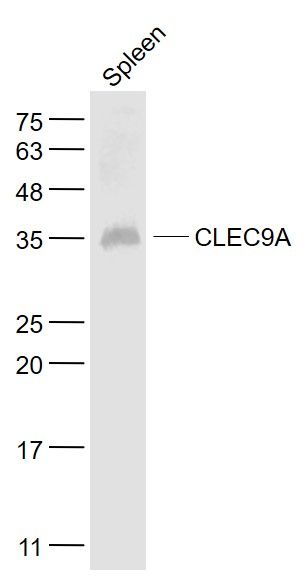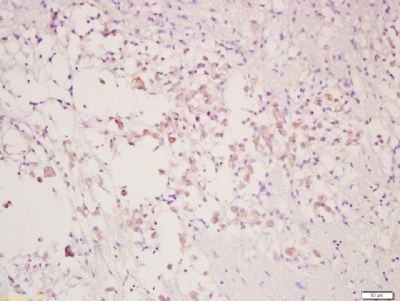The SLCtype lectin/SLCtype lectin-like domain (CTL/CTLD) superfamily consists of a variety of proteins that share a common protein fold and have diverse functions, including cell-cell signaling, cell adhesion, glycoprotein turnover and immune responses. CLESLC9A (SLCtype lectin domain family 9 member A), also known as DNGR1 (dendritic cell natural killer lectin group receptor 1), is a 241 amino acid single-pass type II membrane protein that contains one SLCtype lectin domain and belongs to the CTL/CTLD superfamily. Expressed in myeloid lineage cells, brain, spleen and thymus, CLESLC9A is a group V SLCtype lectin-like receptor (CTLR) that acts as an activation receptor. The gene encoding CLESLC9A maps to human chromosome 12p13.2 and mouse chromosome 6 F3.
Function:
Functions as an endocytic receptor on a small subset of myeloid cells specialized for the uptake and processing of material from dead cells. Recognizes filamentous form of actin in association with particular actin-binding domains of cytoskeletal proteins, including spectrin, exposed when cell membranes are damaged, and mediate the cross-presentation of dead-cell associated antigens in a Syk-dependent manner.
Subcellular Location:
Membrane.
Tissue Specificity:
In peripheral blood highly restricted on the surface of BDCA31(+) dendritic cells and on a small subset of CD14(+) and CD16(-) monocytes.
Post-translational modifications:
N-glycosylated.
Similarity:
Contains 1 SLCtype lectin domain.
SWISS:
Q6UXN8
Gene ID:
283420
Database links:
Entrez Gene: 283420 Human
Omim: 612252 Human
SwissProt: Q6UXN8 Human
Unigene: 531189 Human
| Picture |
Sample:
Spleen (Mouse) Lysate at 40 ug
Primary: Anti- CLEC9A (SL13620R) at 1/1000 dilution
Secondary: IRDye800CW Goat Anti-Rabbit IgG at 1/20000 dilution
Predicted band size: 27 kD
Observed band size: 35 kD
Tissue/cell: rat injured brain; 4% Paraformaldehyde-fixed and paraffin-embedded;
Antigen retrieval: citrate buffer ( 0.01M, pH 6.0 ), Boiling bathing for 15min; Block endogenous peroxidase by 3% Hydrogen peroxide for 30min; Blocking buffer (normal goat serum,SLC0005) at 37℃ for 20 min;
Incubation: Anti-CLEC9A Polyclonal Antibody, Unconjugated(SL13620R) 1:200, overnight at 4°C, followed by conjugation to the secondary antibody(SP-0023) and DAB(SLC0010) staining
|
|
|

